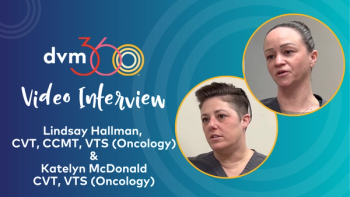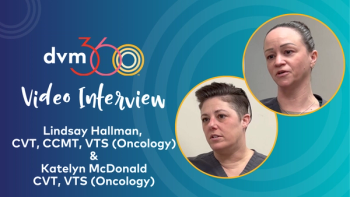
What Are Some Techniques to Safely Approach & Handle Animals?
Debbie Martin, LVT, VTS (Behavior), animal behavior technician for Veterinary Behavior Consultations, co-owner of Team Education in Animal Behavior, explains how Fear Free concepts can alleviate handling- and restrain-induced stress.
Debbie Martin, LVT, VTS (Behavior), animal behavior technician for Veterinary Behavior Consultations, co-owner of Team Education in Animal Behavior, explains how Fear Free concepts can alleviate handling- and restrain-induced stress.
Interview Transcript (slightly modified for readability)
“There are a lot of practices from the Fear Free initiative that will help alleviate the fear and anxiety associated with restraint and handling. [One] of these core concepts of Fear Free is to use a considerate approach, and when we talk about a considerate approach, there are many aspects to that; [it] involves the veterinary team as well as the animals as well as the clients. So, how we’re approaching them in our communication.
A key component of that with our patients is making sure that we’re approaching them in a species-specific way. Now, I’m not suggesting that the veterinary staff has to come up to the dog and sniff [them] as the dog would do, not at all. We can use things like avoiding direct eye contact, which is a threat. We like animals, so we want to go up to them and say hello to them and look them right in the eyes [but] that can actually put the animal off because it’s too much, too soon. I encourage people to play hard to get; let the animal approach you, act as if they’re not there, maybe toss some treats out, and let them decide to warm up and show interest in you instead of you showing that first interest. Let them make the first move.
Another technique would be using gentle control, which is the way that we humanely and safely restrain animals to provide veterinary care to them. We try to use the least amount of restraint as necessary to have the animal stay in position and we’ll incorporate things like a treat distraction or food as a reinforcement for maintaining still and we can get more advanced into that. I’d say [with] about 80% of patients we’re able to distract them and they may not even know [that] a vaccine occurred; they just didn’t even know [that] we did it because it’s really not that uncomfortable, but there are some that are sensitive to touch and handling and we might have to do a little bit more advanced training with them in those cases.
Another concept is a touch gradient and there’s two components to the touch gradient; one is, once we put our hands on a patient, we’re going to try to keep our hands there, so for a physical exam I might first put my hands on the neck or back area of the dog or cat and then gradually glide or slide my hands to the next area that I need to go to. My hands aren’t going on and off, very much like if you’ve ever had a massage; the masseuse, once they’ve touched you, they don’t want to startle you, so they’re always going to keep a hand on you. Anyone that’s worked around large animals knows, you want to make sure that the animal knows where you are because if you startle them it can be dangerous. The same thing, same principles, with our smaller animals, is that we let them know where we are so [that] we’re not startling them or frightening them.
The other aspect of the touch gradient is actually getting them used to increased intensity of touch, so if I’m getting ready to give a vaccine, and I’m going to give it [subcutaneously in] the hind leg, I’m going to [initially] touch the dog or the cat over their back and shoulders, glide my hand down to that area, I might gently pinch and tent the area, pretend I’m poking, and the next one would actually be the injection. It’s not ‘wham-bam-thank-you-ma'am, here’s an injection.’ I get them used to the idea that I’m touching them in this area and something’s happening and they’re being distracted with whether it be petting, food, or treats, during that time.”
Newsletter
From exam room tips to practice management insights, get trusted veterinary news delivered straight to your inbox—subscribe to dvm360.






